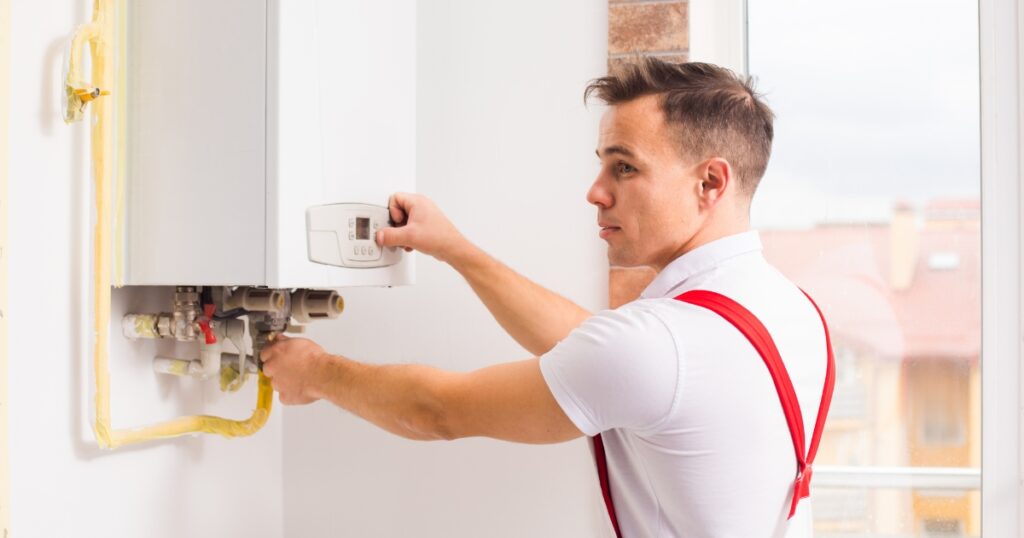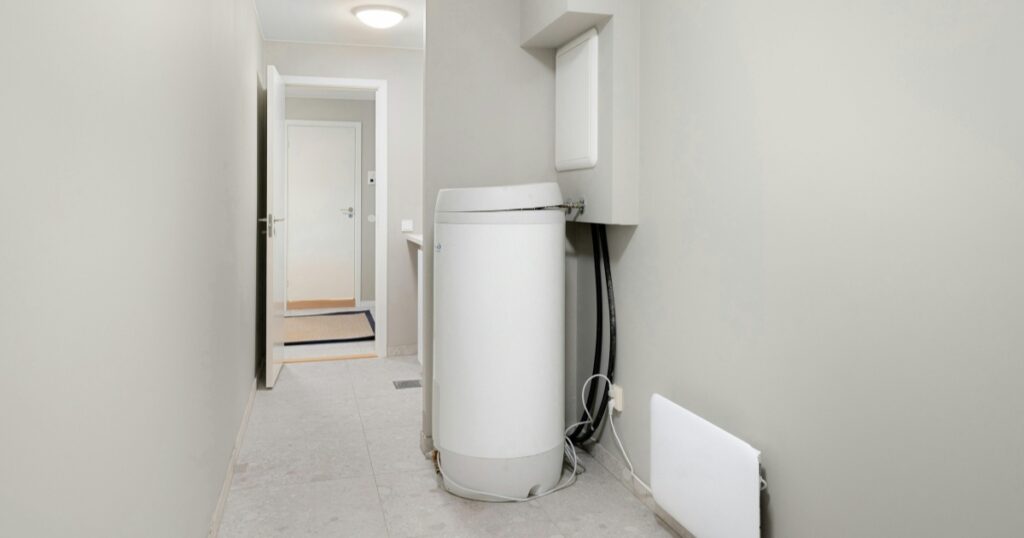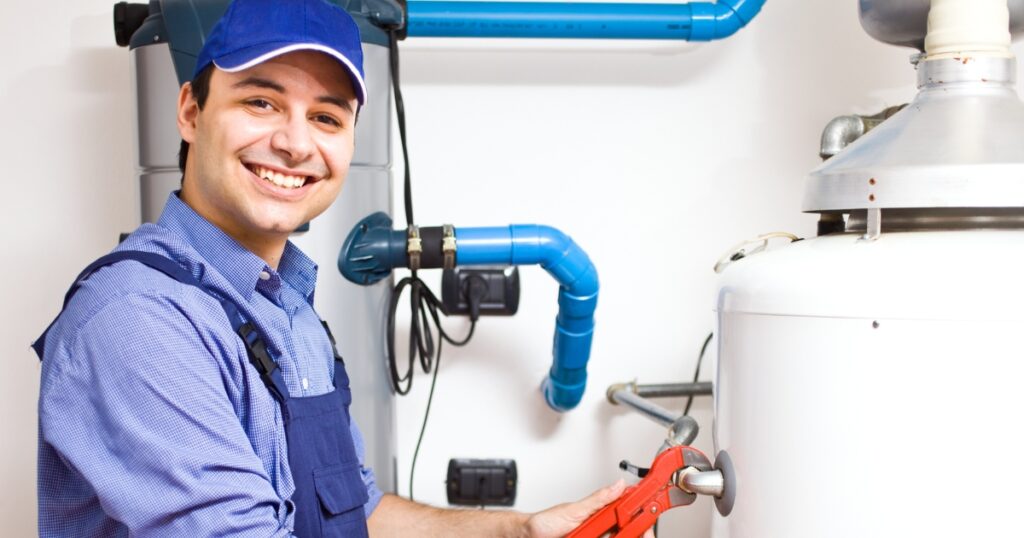Ever had the shock of your life stepping into what you thought would be a steamy shower, only to cop a cold spray instead? Yeah, we know that feeling all too well. It’s enough to make you want to hop straight out and wrap yourself in a towel.
But did you realise that the little champion fighting against these rude awakenings is the thermostat in your hot water system? We’re here to take a proper squiz at how this nifty device keeps your showers comfortably warm.
Stick around – coz’ by the end of our yarn, you’ll be enjoying showers just how they should be: nice and cosy!
Key Takeaways
- Thermostats are essential for keeping your showers warm by constantly checking and adjusting the water temperature to make sure it’s just right.
- Modern thermostats can save you money on energy bills through features like programmable schedules and remote adjustments using smartphone apps.
- Having two thermostats in a hot water system, one at the top and another at the bottom, keeps the heat spread out evenly so there are no cold surprises.
- Smart thermostats learn your routine and tweak the heating schedule, giving you hot water when needed while saving energy when you don’t.
- Heat recovery systems work with thermostats to use waste heat from your hot water usage to warm up incoming cold water, slashing the amount of new energy needed.
Understanding the Function of Thermostats in Hot Water Systems
Thermostats play a critical role in controlling the temperature of hot water systems, ensuring that you have access to hot water at the right temperature whenever you need it. From gas water heaters to electric ones, understanding how thermostats work is crucial for efficient and effective heating.

Controlling water temperature
We understand how crucial it is to have that perfect hot shower at the end of a long day or a cup of tea made with just-right heated water. That’s where the magic of thermostats comes into play in our hot water systems.
These clever devices ensure that the water temperature doesn’t stray from what we’ve set, giving us peace of mind and the comfort we crave.
Managing the heat levels in our electric and gas water heaters, these nifty gadgets act like vigilant guardians. In an electric heater, they’ll switch on and off to keep both upper and lower elements working smoothly, while in gas heaters they stay alert near the bottom, ready to step in when needed.
Always striving for balance, we make sure both thermostats are set equally so everything runs efficiently—no more sudden cold surprises during showers!
Importance of accurate thermostats
Controlling water temperature is crucial, and accurate thermostats play a significant role in maintaining the desired level. Homeowners can rely on accurately calibrated thermostats to ensure that their hot water systems consistently provide the right temperature for various applications.
Properly functioning thermostats also contribute to energy efficiency by avoiding excessive heating or unnecessary energy consumption.
Efficient control of water heater temperature is essential when it comes to saving energy and ensuring comfort. Accurate thermostats enable homeowners to maintain optimal temperatures, preventing any overheating or underheating issues.
Advancements in thermostat technology
Advancements in thermostat technology have revolutionised hot water systems, offering more precise temperature control and improved energy efficiency. Modern thermostats come equipped with advanced features such as programmable schedules, remote access via smartphone apps, and adaptive learning capabilities.
These features allow homeowners to customise their hot water usage patterns, ensure optimal comfort, and maximise energy savings. Furthermore, smart thermostats can also provide valuable insights into water heating trends and consumption patterns, empowering users to make informed decisions for efficient energy use.
Thermostat technology has evolved significantly to include sensor-based temperature monitoring and automatic adjustment algorithms that optimise the performance of water heaters.
The Significant Role of Thermostats in Maintaining Water Heater Temperatures
Thermostats play a crucial role in ensuring consistent water temperatures in hot water systems. They help maintain the desired temperature, providing convenience and comfort to households.
With advanced features, modern thermostats can efficiently regulate water heater temperatures for optimal performance.
Ensures consistent temperature
Thermostats play a crucial role in maintaining the consistent temperature of hot water systems. They continually monitor and adjust the water temperature to ensure it remains at the desired level, providing comfort and reliability for various household applications.
With separate thermostats controlling each element of the water heater, they work together to maintain a uniform temperature throughout the entire system. This ensures that you always have access to hot water when you need it, without any unexpected fluctuations.
Moving on to “The Impact of Thermostats on Energy Efficiency in Water Heating Systems,” let’s explore how these devices help maximise energy efficiency and reduce utility costs for homeowners.
Advantages of thermostat use
Thermostats in hot water systems offer several advantages for homeowners. They help maintain a consistent and comfortable water temperature, ensuring it’s suitable for various household tasks.
By regulating the water heater temperature, thermostats play a crucial role in energy efficiency, helping to reduce utility costs. Additionally, they allow for precise control over the water temperature, providing convenience and peace of mind for homeowners who want reliable access to hot water whenever they need it.
With smart thermostat technology and accurate monitoring capabilities, we can make informed decisions about our daily hot water usage. This means less wasted energy and increased savings on monthly utility bills without sacrificing comfort or convenience.

The Impact of Thermostats on Energy Efficiency in Water Heating Systems
Maximising energy efficiency is crucial in water heating, and smart thermostats play a significant role in achieving this goal. They help to regulate the temperature more accurately, reducing unnecessary energy consumption.
Maximising energy efficiency
To maximise energy efficiency, we ensure that our thermostats accurately regulate water temperature. This allows us to avoid unnecessary energy usage by maintaining the water at the desired level and minimising heat loss from the system.
Smart thermostat technology enables us to programme and control our hot water systems efficiently, contributing to overall energy savings.
By incorporating heat recovery systems in conjunction with thermostats, we leverage waste heat from various processes to preheat incoming cold water. This approach reduces the energy required to reach the desired temperature, further enhancing our hot water system’s efficiency.
Role of smart thermostats
Smart thermostats are revolutionising the way we manage hot water systems, offering advanced features for precise temperature control and energy efficiency. These high-tech devices allow homeowners to remotely monitor and adjust their water heater settings, optimising comfort and reducing energy consumption.
With the ability to learn household usage patterns, smart thermostats can automatically adjust temperatures at specific times, ensuring hot water is available when needed while conserving energy during off-peak hours.
By integrating with other smart home systems, these thermostats play a pivotal role in enhancing overall climate control and promoting sustainable living.
As technology continues to evolve, the integration of smart thermostats into hot water systems offers unparalleled convenience and efficiency for homeowners. Their adaptability and intuitive operation contribute significantly to the more seamless management of water heating resources in modern households.
Heat recovery systems in water heating
Heat recovery systems in water heating work by capturing and reusing heat that would otherwise be lost. These systems can significantly improve energy efficiency, resulting in reduced energy costs for homeowners.
By using a heat exchanger, the recovered thermal energy from the hot water system can be utilised to preheat incoming cold water, effectively reducing the workload on the primary heating source and conserving energy.
Implementing such systems can lead to substantial savings on utility bills while also promoting environmentally friendly practices.
By integrating heat recovery systems into their hot water setups, homeowners can minimise their environmental impact and enjoy increased cost-effectiveness without compromising on comfort or convenience.
Exploring the Perfect Balance: Thermostats and Heat Recovery
In this section, we will delve into the function of thermostats in heat recovery systems and explore the benefits of incorporating heat recovery technology into hot water systems. We’ll discuss how these two elements work together to maximise energy efficiency and maintain consistent water temperatures.
Function of thermostats in heat recovery systems
Thermostats in heat recovery systems regulate the temperature of the water to ensure it matches the needs of the household. They work in tandem with heat recovery units to optimise energy efficiency by controlling when and how much hot water is generated, reducing wastage and providing consistent supply.
The thermostats monitor and adjust the water heater’s operation, maximising heat recovery potential while maintaining a constant output temperature, thus contributing significantly to overall energy savings.
The thermostat’s role in a heat recovery system is crucial for enabling efficient hot water usage without compromising on comfort or convenience. By working seamlessly with the heat recovery unit, thermostats play an essential part in ensuring that households have access to consistently heated water while also minimising energy consumption.
Benefits of heat recovery
Maximising energy efficiency in hot water systems, heat recovery is a key benefit of smart thermostat integration. By capturing and reusing heat that would otherwise be lost during the heating process, heat recovery systems can significantly reduce energy consumption and operating costs.
This not only helps to lower utility bills but also decreases the overall environmental impact of hot water systems. Additionally, integrating heat recovery with thermostats ensures a more sustainable approach to water heating while maintaining consistent temperature levels for various household applications.
Moreover, incorporating heat recovery into hot water systems reduces reliance on traditional heating methods, leading to extended lifespan and reduced wear on home appliances. This results in decreased maintenance needs and ultimately enhances the overall performance and longevity of the system.
Learn More about Thermostat
In conclusion, thermostats are crucial for controlling and maintaining the temperature of hot water systems. They play a significant role in ensuring consistent and efficient water heating, ultimately contributing to energy savings.
With advancements in thermostat technology, they have become essential devices for regulating water heater temperatures and maximising energy efficiency in homes. Furthermore, the use of smart thermostats further enhances the control and management of hot water systems, making them an indispensable component for every homeowner seeking reliable and efficient hot water solutions.






